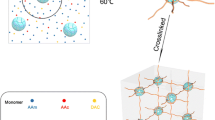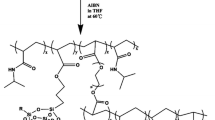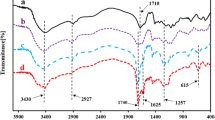Abstract
In this contribution, we reported the synthesis of poly(N-isopropylacrylamide)-block-poly(acrylic acid) (PNIPAAm-b-PAA) copolymer networks via sequential reversible addition-fragmentation chain transfer (RAFT) polymerization. The PNIPAAm-b-PAA block copolymer networks were characterized by means of Fourier transform infrared spectroscopy (FTIR) and small angle X-ray scattering (SAXS). The volume phase transition (VPT) temperatures of the PNIPAAm-b-PAA hydrogels were measured by means of micro-differential scanning calorimetry (micro-DSC). It was found that the block copolymer hydrogels displayed the VPT temperatures lower than the control PNIPAAm hydrogel. Compared to the control PNIPAAm hydrogel, the deswelling and reswelling properties of the block copolymer hydrogels were significantly improved. The improved thermoresponsive properties of the PNIPAAm-b-PAA hydrogels have been interpreted on the basis of the formation of the architecture of the block copolymer networks.









Similar content being viewed by others
References
Lutz J-F, Akdemir Ö, Hoth A (2006) Point by point comparison of two thermosensitive polymers exhibiting a similar LCST: is the age of poly (NIPAM) over? J Am Chem Soc 128:13046–13047
Lutz J-F, Hoth A (2006) Preparation of ideal PEG analogues with a tunable thermosensitivity by controlled radical copolymerization of 2-(2-methoxyethoxy) ethyl methacrylate and oligo (ethylene glycol) methacrylate. Macromolecules 39:893–896
Hoffman A, Stayton P, El-Sayed M, Murthy N, Bulmus V, Lackey C, Cheung C (2007) Design of “smart” nano-scale delivery systems for biomolecular therapeutics. J Biomed Nanotechnol 3:213–217
Lee Y, Fukushima S, Bae Y, Hiki S, Ishii T, Kataoka K (2007) A protein nanocarrier from charge-conversion polymer in response to endosomal pH. J Am Chem Soc 129:5362–5363
Matsuda N, Shimizu T, Yamato M, Okano T (2007) Tissue engineering based on cell sheet technology. Adv Mater 19:3089–3099
Magnusson JP, Khan A, Pasparakis G, Saeed AO, Wang W, Alexander C (2008) Ion-sensitive “isothermal” responsive polymers prepared in water. J Am Chem Soc 130:10852–10853
Shimoboji T, Larenas E, Fowler T, Kulkarni S, Hoffman AS, Stayton PS (2002) Photoresponsive polymer–enzyme switches. Proc Natl Acad Sci 99:16592–16596
Jonas AM, Glinel K, Oren R, Nysten B, Huck WT (2007) Thermo-responsive polymer brushes with tunable collapse temperatures in the physiological range. Macromolecules 40:4403–4405
Oh JK, Siegwart DJ, H-i L, Sherwood G, Peteanu L, Hollinger JO, Kataoka K, Matyjaszewski K (2007) Biodegradable nanogels prepared by atom transfer radical polymerization as potential drug delivery carriers: synthesis, biodegradation, in vitro release, and bioconjugation. J Am Chem Soc 129:5939–5945
Kikuchi A, Okano T (2002) Intelligent thermoresponsive polymeric stationary phases for aqueous chromatography of biological compounds. Prog Polym Sci 27:1165–1193
Gil ES, Hudson SM (2004) Stimuli-responsive polymers and their bioconjugates. Prog Polym Sci 29:1173–1222
Gutowska A, Bae YH, Feijen J, Kim SW (1992) Heparin release from thermosensitive hydrogels. J Control Release 22:95–104
Stenzel MH, Davis TP (2002) Star polymer synthesis using trithiocarbonate functional β–cyclodextrin cores (reversible addition–fragmentation chain–transfer polymerization). J Polym Sci A Polym Chem 40:4498–4512
Wu XS, Hoffman AS, Yager P (1992) Synthesis and characterization of thermally reversible macroporous poly (N–isopropylacrylamide) hydrogels. J Polym Sci A Polym Chem 30:2121–2129
Hoare T, Pelton R (2007) Engineering glucose swelling responses in poly (N-isopropylacrylamide)-based microgels. Macromolecules 40:670–678
Zhang X-Z, Xu X-D, Cheng S-X, Zhuo R-X (2008) Strategies to improve the response rate of thermosensitive PNIPAAm hydrogels. Soft Matter 4:385–391
Yoshida R, Uchida K, Kaneko Y, Sakai K, Kikuchi A, Sakurai Y, Okano T (1995) Comb-type grafted hydrogels with rapid deswelling response to temperature changes. Nature 374:240–242
Wu C, Zhou S (1997) Volume phase transition of swollen gels: discontinuous or continuous? Macromolecules 30:574–576
Heskins M, Guillet JE (1968) Solution properties of poly (N-isopropylacrylamide). J Macromol Sci Chem 2:1441–1455
Kujawa P, Tanaka F, Winnik FM (2006) Temperature-dependent properties of telechelic hydrophobically modified poly (N-isopropylacrylamides) in water: evidence from light scattering and fluorescence spectroscopy for the formation of stable mesoglobules at elevated temperatures. Macromolecules 39:3048–3055
Yin X, Hoffman AS, Stayton PS (2006) Poly (N-isopropylacrylamide-co-propylacrylic acid) copolymers that respond sharply to temperature and pH. Biomacromolecules 7:1381–1385
Ta A, Kaneko T, Matsusaki M, Akashi M (2006) Rapid and precise release from nano–tracted poly (N–isopropylacrylamide) hydrogels containing linear poly (acrylic acid). Macromol Biosci 6:959–965
Zhu PW, Napper DH (1994) Experimental observation of coil-to-globule type transitions at interfaces. J Colloid Interface Sci 164:489–494
Shan J, Chen J, Nuopponen M, Tenhu H (2004) Two phase transitions of poly (N-isopropylacrylamide) brushes bound to gold nanoparticles. Langmuir 20:4671–4676
Zhuo RX, Li W (2003) Preparation and characterization of macroporous poly (N–isopropylacrylamide) hydrogels for the controlled release of proteins. J Polym Sci A Polym Chem 41:152–159
Kato N, Sakai Y, Shibata S (2003) Wide-range control of deswelling time for thermosensitive poly (N-isopropylacrylamide) gel treated by freeze-drying. Macromolecules 36:961–963
Zhang X-Z, Yang Y-Y, Chung T-S, Ma K-X (2001) Preparation and characterization of fast response macroporous poly (N-isopropylacrylamide) hydrogels. Langmuir 17:6094–6099
Serizawa T, Wakita K, Akashi M (2002) Rapid deswelling of porous poly (N-isopropylacrylamide) hydrogels prepared by incorporation of silica particles. Macromolecules 35:10–12
Annaka M, Matsuura T, Kasai M, Nakahira T, Hara Y, Okano T (2003) Preparation of comb-type N-isopropylacrylamide hydrogel beads and their application for size-selective separation media. Biomacromolecules 4:395–403
Guiseppi-Elie A, Sheppard NF, Brahim S, Narinesingh D (2001) Enzyme microgels in packed–bed bioreactors with downstream amperometric detection using microfabricated interdigitated microsensor electrode arrays. Biotechnol Bioeng 75:475–484
Cong H, Li L, Zheng S (2013) Poly (N-isopropylacrylamide)-block-poly (vinyl pyrrolidone) block copolymer networks: synthesis and rapid thermoresponse of hydrogels. Polymer 54:1370–1380
Nykänen A, Nuopponen M, Laukkanen A, Hirvonen S-P, Rytelä M, Turunen O, Tenhu H, Mezzenga R, Ikkala O, Ruokolainen J (2007) Phase behavior and temperature-responsive molecular filters based on self-assembly of polystyrene-block-poly(N-isopropylacrylamide)-block-polystyrene. Macromolecules 40:5827–5834
Kaneko Y, Nakamura S, Sakai K, Aoyagi T, Kikuchi A, Sakurai Y, Okano T (1998) Rapid deswelling response of poly (N-isopropylacrylamide) hydrogels by the formation of water release channels using poly (ethylene oxide) graft chains. Macromolecules 31:6099–6105
Hayashi H, Kono K, Takagishi T (1998) Temperature-dependent associating property of liposomes modified with a thermosensitive polymer. Bioconjug Chem 9:382–389
Song J, Yu R, Wang L, Zheng S, Li X (2011) Poly (N-vinylpyrrolidone)-grafted poly(N-isopropylacrylamide) copolymers: synthesis, characterization and rapid deswelling and reswelling behavior of hydrogels. Polymer 52:2340–2350
Zheng Q, Zheng S (2012) From poly (N–isopropylacrylamide)–block–poly (ethylene oxide)–block–poly(N–isopropylacrylamide) triblock copolymer to poly (N–isopropylacrylamide)–block–poly (ethylene oxide) hydrogels: synthesis and rapid deswelling and reswelling behavior of hydrogels. J Polym Sci A Polym Chem 50:1717–1727
Zheng Y, Zheng S (2012) Poly (ethylene oxide)-grafted poly (N-isopropylacrylamide) networks: preparation, characterization and rapid deswelling and reswelling behavior of hydrogels. React Funct Polym 72:176–184
Yu R, Zheng S (2011) Poly (acrylic acid)-grafted poly (N-isopropyl acrylamide) networks: preparation, characterization and hydrogel behavior. J Biomater Sci Polym Ed 22:2305–2324
Johnson RS, Finnegan PS, Wheeler DR, Dirk SM (2011) Photopatterning poly (p-phenylenevinylene) from xanthate precursor polymers. Chem Commun 47:3936–3938
Mano V, Silva RE, Scarpelli ME, Barbani N, Giusti P (2004) Binary blends based on poly (N–isopropylacrylamide): miscibility studies with PVA, PVP, and PAA. J Appl Polym Sci 92:743–748
Haraguchi K, Takehisa T, Fan S (2002) Effects of clay content on the properties of nanocomposite hydrogels composed of poly (N-isopropylacrylamide) and clay. Macromolecules 35:10162–10171
Haraguchi K, Farnworth R, Ohbayashi A, Takehisa T (2003) Compositional effects on mechanical properties of nanocomposite hydrogels composed of poly (N, N-dimethylacrylamide) and clay. Macromolecules 36:5732–5741
Yi F, Zheng S (2009) Effect of hydrophobic polystyrene microphases on temperature-responsive behavior of poly(N-isopropylacrylamide) hydrogels. Polymer 50:670–678
Kaneko Y, Sakai K, Kikuchi A, Yoshida R, Sakurai Y, Okano T (1995) Influence of freely mobile grafted chain length on dynamic properties of comb-type grafted poly(N-isopropylacrylamide) hydrogels. Macromolecules 28:7717–7723
Janovák L, Varga J, Kemény L, Dékány I (2008) Investigation of the structure and swelling of poly(N-isopropyl-acrylamide-acrylamide) and poly(N-isopropyl-acrylamide-acrylic acid) based copolymer and composite hydrogels. Colloid Polym Sci 286:1575–1585
Zhang J, Chu L-Y, Li Y-K, Lee YM (2007) Dual thermo and pH-sensitive poly(N-isopropylacrylamide-co-acrylic acid) hydrogels with rapid response behaviors. Polymer 48:1718–1728
Champ S, Xue W (2000) Concentrating aqueous solutions of water soluble polymers by thermoreversible swelling of poly [(N–isopropylacrylamide)–co–(acrylic acid)] hydrogels. Macromol Chem Phys 201:931–940
Yoo MK, Seok WK, Sung YK (2004) Characterization of stimuli–sensitive polymers for biomedical applications. In Macromol. Symp.; Wiley Online Library, Vol. 207: pp 173-186
Tian Q, Zhao X, Tang X, Zhang Y (2003) Hydrophobic association and temperature and pH sensitivity of hydrophobically modified poly (N–isopropylacrylamide/acrylic acid) gels. J Appl Polym Sci 87:2406–2413
Adem E, Burillo G, Bucio E, Magaña C, Avalos-Borja M (2009) Characterization of interpenetrating networks of acrylic acid (AAc) and N-isopropylacrylamide (NIPAAm) synthesized by ionizing radiation. Radiat Phys Chem 78:549–552
Burillo G, Briones M, Adem E (2007) IPN’s of acrylic acid and N-isopropylacrylamide by gamma and electron beam irradiation. Nucl Inst Methods Phys Res B 265:104–108
Xia X, Hu Z, Marquez M (2005) Physically bonded nanoparticle networks: a novel drug delivery system. J Control Release 103:21–30
Beltran S, Baker JP, Hooper HH, Blanch HW, Prausnitz JM (1991) Swelling equilibria for weakly ionizable, temperature-sensitive hydrogels. Macromolecules 24:549–551
Feil H, Bae YH, Feijen J, Kim SW (1993) Effect of comonomer hydrophilicity and ionization on the lower critical solution temperature of N-isopropylacrylamide copolymers. Macromolecules 26:2496–2500
Glatter O, Kratky O (1982) Small angle X-ray scattering; Academic press London, Vol. 102, pp 215–236
Díez-Peña E, Quijada-Garrido I, Barrales-Rienda J (2002) Hydrogen-bonding effects on the dynamic swelling of P (NIPAAm-co-MAA) copolymers. A case of autocatalytic swelling kinetics. Macromolecules 35:8882–8888
Bekturov EA, Bimendina LA (1981) Interpolymer complexes. In Speciality polymers; Springer, pp 99-147
Tsuchida E, Abe K (1982) Interactions between macromolecules in solution and intermacromolecular complexes; Springer, pp 1-119
Bokias G, Staikos G, Iliopoulos I (2000) Solution properties and phase behaviour of copolymers of acrylic acid with N-isopropylacrylamide: the importance of the intrachain hydrogen bonding. Polymer 41:7399–7405
Acknowledgments
The financial support from the Natural Science Foundation of China (nos. 51133003 and 21274091) was gratefully acknowledged. The authors thank the Shanghai Synchrotron Radiation Facility for support under project nos. 10 sr0260 and 10 sr0126.
Author information
Authors and Affiliations
Corresponding author
Rights and permissions
About this article
Cite this article
Cong, H., Zheng, S. Poly(N-isopropylacrylamide)-block-poly(acrylic acid) hydrogels: synthesis and rapid thermoresponsive properties. Colloid Polym Sci 292, 2633–2645 (2014). https://doi.org/10.1007/s00396-014-3314-9
Received:
Revised:
Accepted:
Published:
Issue Date:
DOI: https://doi.org/10.1007/s00396-014-3314-9




